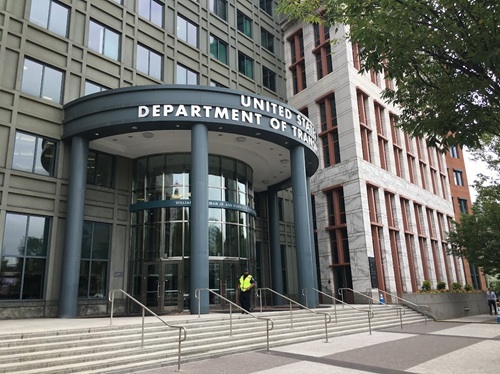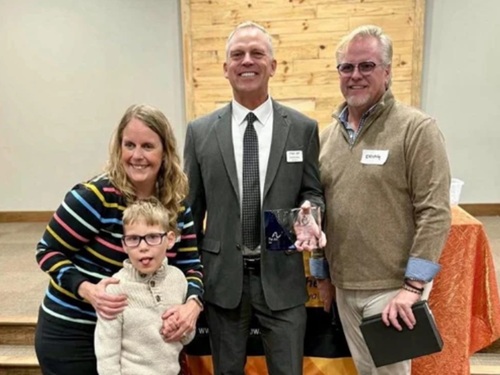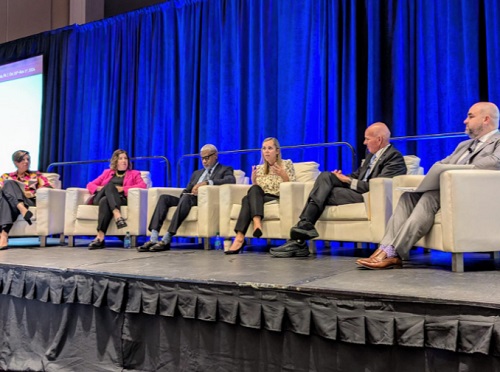A panel discussion at the 2024 American Association of State Highway and Transportation Officials Annual Meeting in Philadelphia talked about a range of workforce issues facing state departments of transportation around the country – and what to do about them.
[Above photo by AASHTO]
“The most pressing issue we deal with every day are workforce challenges,” noted Garrett Eucalitto – commissioner of the Connecticut Department of Transportation and AASHTO president – who moderated the discussion.
“All of us face this; how the private sector competes for the same pool of workers; the struggle to maintain high skill levels; high turnover due to generational change; compensation disparity; and especially career awareness among Generation Z,” he said. “Many ‘Gen Z’ workers remain unaware of the rewards public service offers; many often view state DOTs as less innovative, which is not true. We have to engage younger workers better and communicate better; we need to show them that, yes, we do cool stuff in transportation.”
Carlos Braceras, executive director of the Utah Department of Transportation, chair of the AASHTO Agency Administration Managing Committee and a former AASHTO president, stressed that while pay is important to attract people into state DOT workforces, it won’t be what keeps them there long term.
“A fair and competitive wage needs to be the baseline through which we create the workforce we need, but you cannot build a great workforce through pay,” he stressed. “You have to build it through culture; where people feel their worth, they feel safe, and it is OK to have fun. It is not just important to attract talent – we have to create a place people want to stay and grow with the organization.”
Braceras said leadership is the “number one thing” in achieving that, as state DOT leaders must shape the strategic vision for the organization then create and a foster culture to reach that vision.
Yet it is also critical for leaders to make work flexible; that it is not the only thing that matters. “You have to recognize that the work we do is important, but that we also can sometimes become obsessed with the work,” he emphasized. “Work is only one of the four balls we as people juggle: they are family, health, spirituality, and work. Three of them are glass – you cannot drop them – while the work ‘ball’ is rubber; it will bounce back.”
Nicole Majeski, secretary of the Delaware Department of Transportation and chair of the AASHTO Council on Public Transportation, stressed that the workforce state DOTs now recruit from is very different from the past.
“It is a very different workforce market we are working with now,” she said. “People are not coming here to spend 20 to 30 years of their career – they may try it for a couple of years and then move on,” she explained. “We are getting shorter term employees; not lifetime workers anymore. So we have to change and be more flexible, such as by offering more remote work and training opportunities.”
To that end, Majeski said Delaware DOT is partnering more with universities, high schools, and vocational technical schools to recruit new workers – and also to recruit workers with skill sets not needed in the past.
“Our jobs are evolving – we have for example, electric and hydrogen [powered] fleet vehicles. So the skill sets involved with vehicle [maintenance] has changed,” she said. “Also, to create a workforce where we are innovative means we have to take risks to a certain extent. We also have to stress what the best thing is working for us: that the work we do impacts everyone in our state; their quality of life. Making a difference and seeing direct impact of what we do will help us recruit and retain new workers.”
Brandye Hendrickson, deputy executive director for planning and administration at the Texas Department of Transportation, added that state DOTs also need to review all of their current job descriptions to look at what is “truly required” to be successful in those positions.
“Maybe some of those jobs do not require an engineering degree; maybe no degree is required at all,” she explained. “This provides an opportunity to widen the net for more candidates.”
Hendrickson also noted that empowering front line managers to take action is critical. “Our managers are empowered to create action plans based off employee survey responses. That shows our people that we take [those surveys] seriously,” she said. “We also look to create support groups for specific sectors of our workforce as well, so they can share the common challenges they may face.”
Leslie Richards, CEO and general manager of the Southeastern Pennsylvania Transportation Authority (SEPTA) and a former secretary of the Pennsylvania Department of Transportation, added that “listening to employees; letting them know you are trying to make their quality of life better” is vital to those workforce retention efforts.
“In terms of retention, it is important that our workers know what the paths are; and that they will receive support and training along the way,” she said. “We need to make sure that everyone feels heard; that they know where they can go if they have a concern. And management must have follow through on those concerns.”
Lester Woods, chief administrative officer for the Missouri Department of Transportation, said it is also incumbent of state DOTs to highlight the full breadth of the jobs they offer as well as engage in “grow our own” workforce efforts.
“Employees are an essential part of our department – we have a lot going on but we do not have enough people doing the jobs,” he said. “The only thing many know about the state DOT are our buses, trains, and big trucks – they don’t know about the technology we operate or the legal and other services we provide. We need to expose those facets to our communities.”
Woods stressed that state DOTs need to find ways to “grow their own” workers as well – recruiting high school or younger students. “If you can attract young people at an early age and expose them to our [state DOT] opportunities it is worth the investment,” he said. “If we can show them what we do at an earlier age, it is easier to attract them later on.
He also pointed to the work Missouri DOT has been doing with the “Jobs for American Graduates” program over the last two or three years; working with disadvantaged youths “before they fall through the cracks” so they can roll into a career after high school graduation.
“We also open the door to work 32 hours a week and go to college full time, receive salary and benefits,” Woods said. “Then when they are [ready] they come work for us for 40 hours a week.”
 Top Stories
Top Stories
USDOT Issues $1B in Local Road Safety Funding
January 2, 2026 Top Stories
Top Stories

